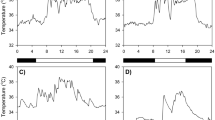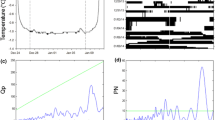Summary
Body temperatures (T b) and daily activity patterns of free-living arctic ground squirrells (Spermophilus undulatus) were determined via telemetry at a field site in northern Alaska. Simultaneous measurements were made of ambient temperature (T a), wind speed (V), and incident solar radiation. The operative environmental temperature (T e) for ground squirrels was obtained from fur-covered, thin metal taxidermic models of the animals. Standard operative temperature (T es), a comparative index of heat flow, was calculated from T e, V, and laboratory measurements of thermal conductivity.
During the period of the study (August), S. undulatus were active for about 14 h per day (06.00 to 20.00 h). T b was high throughout the daily cycle, averaging 38–39°C. Circadian variations in T b were slight; average T b values dropped <1°C at night. Daytime T b fluctuations were not closely correlated to activity or to changes in environmental conditions. Air temperatures during the study were low, usually between 10 and 15°C during the day. However, T es in exposed areas was normally higher, even though skies were generally overcast. During periods of sunshine, T es may be as high as 34°C. The absence of nocturnal activity may result from increased costs of thermoregulation at night, which sharply reduces foraging efficiency. The high and stable body temperatures of S. undulatus probably result from thermoneutral daytime T es, low activity levels, and the use of well-insulated nests.
Similar content being viewed by others
References
Bakken GS (1976) A heat transfer analysis of animals: Unifying concepts and the application of metabolism chamber data to field ecology. J Theoret Biol 60:337–384
Bakken GS (1980) The use of standard operative temperature in the study of the thermal energetics of birds. Physiol Zool 53:108–119
Bakken GS, Gates DM (1975) Heat-transfer analysis of animals: Some implications for field ecology, physiology, and evolution. In: DM Gates, RB Schmerl (eds), Perspectives of Biophysical Ecology. Springer, Berlin Heidelberg New York, p 255–290
Bartholomew GA (1972) Aspects of timing and periodicity of hypothermia. In: South FE (ed), Hibernation and Hypothermia: Perspectives and Challenges. Elsevier Publishing Co., New York, pp 663–680
Bartholomew GA (1977) Body temperature and energy metabolism. In: Gordon MS (ed), Animal Physiology, Principles and Adaptations. MacMillan, New York, pp 364–449
Carl EA (1971) Population control in arctic ground squirrels. Ecology 52:395–413
Chappell MA (1980a) Thermal energetics of chicks of arctic-breeding shorebirds. Comp Biochem Physiol 65:311–317
Chappell MA (1980b) Insulation, radiation, and convection in small arctic mammals. J Mammal 61:268–277
Chappell MA (1980c) Thermal energetics and cost of thermoregulation in small arctic mammals. J Mammal 61:278–291
Chappell MA, Bartholomew GA (1981a) Standard operative temperatures and thermal energetics of the antelope ground squirrel Ammospermophilus leucurus. Physiol Zool 54:81–93
Chappell MA, Bartholomew GA (1981b) Activity and thermoregulation of the antelope ground squirrel, Ammospermophilus leucurus, in winter and summer. Physiol Zool 54:215–223
Davis LB, Birkebak RC (1974) On the transfer of energy in layers of fur. Biophys J 14:249–286
Folk GE, Folk MA (1964) Continuous physiological measurements from unrestrained arctic ground squirrels (Citellus parryi). Annal Acad Sci Fenn Ser A IV 71:157–173
French AR (1976) Selection of high temperatures for hibernation by the pocket mouse Perognathus longimembris: Ecological advantages and energetic consequences. Ecology 57:185–191
Gagge AP (1940) Standard operative temperature. A generalized temperature scale applicable to direct and partitional calorimetry. Am J Physiol 131:93–103
Gessaman JA (1972) Bioenergetics of the snowy owl (Nyctea scandiaca). Arctic and Alpine Res 4:223–238
Golightly RT, Ohmart RD (1978) Heterothermy in free-ranging Abert's squirrels (Sciurus aberti). Ecology 59:897–909
Krog J (1954) Storing of food items in the winter nest of the Alaskan ground squirrel, Citellus undulatus. J Mammal 35:586
Mayer WV (1953) A preliminary study of the Barrow ground squirrel, Citellus parryi barrowensis. J Mammal 34:334–345
Morhardt SS, Gates DM (1974) Energy-exchange analysis of the Belding ground squirrel and its habitat. Ecol Monogr 44:17–44
Morrison DW (1978) Foraging ecology and energetics of the frugivorous bat Artibeus jamaicensis. Ecology 59:716–723
Morrison P, Galster W (1975) Patterns of hibernation in the arctic ground squirrel. Can J Zool 53:1345–1355
Porter WP, Gates DM (1969) Thermodynamic equilibria of animals with environment. Ecol Monogr 39:227–244
Robinson DE, Campbell GS, King JR (1976) An evaluation of heat exchange in small birds. J Comp Physiol 105:153–166
Scholander PF, Hock R, Walters V, Irving L (1950) Adaptation to cold in arctic and tropical mammals and birds in relation to body temperature, insulation, and basal metabolic rate. Biol Bull 99:259–271
Tucker VA (1966) Diurnal torpor and its relation to food consumption and weight changes in the California pocket mouse, Perognathus californicus. Ecology 47:245–252
Wang LC (1972) Circadian body temperature of Richardson's ground squirrel under field and laboratory conditions: A comparative study. Comp Biochem Physiol 43A:503–510
Withers PC, Casey TM, Casey KK (1979) Allometry of respiratory and haematological parameters of arctic mammals. Comp Biochem Physiol 64A:342–349
Author information
Authors and Affiliations
Rights and permissions
About this article
Cite this article
Chappell, M.A. Standard operative temperatures and cost of thermoregulation in the arctic ground squirrel, Spermophilus undulatus . Oecologia 49, 397–403 (1981). https://doi.org/10.1007/BF00347606
Received:
Issue Date:
DOI: https://doi.org/10.1007/BF00347606




